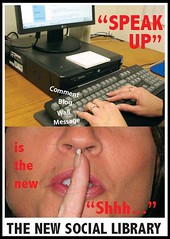The term Library 2.0 was first used by Michael Casey in his blog Library Crunch in 2005. It is obviously a direct appropriation of the term Web 2.0. He and others use the term to imply that the same underlying concepts that have made Web 2.0 tools so popular - community building, user participation, constant beta, etc. - also have value for library services.
Here's the definition of Library 2.0 from Wikipedia:
There has been much debate in the blogosphere about what the term Library 2.0 means and what a 2.0 library would/should look like. Some people argue that technology is a vital part of Library 2.0. Others suggest that it's not about the technology but rather creating user driven services and the technology is only one way to achieve this goal. Then there are those who have suggested that libraries have always been in the business of user driven services and that Library 2.0 is a meaningless label....Casey suggested that libraries, especially public libraries, are at a crossroads where many of the elements of Web 2.0 have applicable value within the library community, both in technology-driven services and in non-technology based services. In particular, he described the need for libraries to adopt a strategy for constant change while promoting a participatory role for library users...
...With Library 2.0, library services are frequently evaluated and updated to meet the changing needs of library users. Library 2.0 also calls for libraries to encourage user participation and feedback in the development and maintaining of library services. The active and empowered library user is a significant component of Library 2.0. With information and ideas flowing in both directions – from the library to the user and from the user to the library – library services have the ability to evolve and improve on a constant and rapid basis. The user is participant, co-creator, builder and consultant – whether the product is virtual or physical.
In this task you will take a deeper look at Library 2.0 and explore how you personally feel about the concept.
First...
Read the following article:
Michael E. Casey and Laura C. Savastinuk. Library 2.0: Service for the next-generation library in Library Journal, 1 September 2006.
Next...
Using the knowledge you have developed during the program locate some other librarians’ perspectives on Web 2.0 and Library 2.0. Some starting points might be:
- The Library 2.0 Reading List on Squidoo.
- The Techsource blog from the American Library Association.
- Some names to look out for include Michael Casey, Michael Stephens, Casey Bisson, Jenny Levine, David Lee King, John Blyberg and Stephen Abram.
You will be able to track down plenty of discussion about the topic. Do some reading and ponder what Library 2.0 means to you. Think about the ways that some of the tools you have explored in this program could be used in a public library context.
Finally...
Post your thoughts about Library 2.0 to your blog. Where do you stand on the Library 2.0 spectrum? Is Web 2.0/Library 2.0 relevant to you... our library... our customers? Can you see any ways in which the tools you have explored could improve our service offering?
Extension...
Keep exploring! Make this the beginning of your journey instead of the end.
Try out some other tools eg. LibraryThing, Google Maps, Rollyo, or something from the Web 2.0 Awards. Keep learning new tools with Learning 2.1.
Take a moment now to make sure your tracking log profile is up to date. Only those who have a blog posting listed for each task before March 1 will be eligible for the incentive prize draw.
Thanks for participating and good luck with the draw!


No comments:
Post a Comment